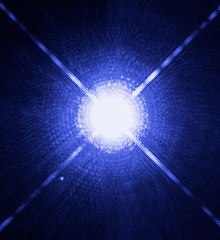Portal:Radiation astronomy/X-ray astronomy article/16
Compare the Chandra X-ray Observatory X-ray image with the Hubble Space Telescope visual image. Sirius A is spectral type A1V, whereas Sirius B is a white dwarf of type DA2.


With the initial detection of an extrasolar X-ray source, the first question usually asked is "What is the source?" An extensive search, such as from a list of stars by constellation, is often made in other wavelengths such as visible or radio for possible coincident objects. But, there are inherent difficulties in making X-ray/optical, X-ray/radio, and X-ray/X-ray identifications based solely on positional coincidents, especially with handicaps in making identifications, such as the large uncertainties in positional determinants made from balloons and rockets, poor source separation in the crowded region toward the galactic center, source variability, and the multiplicity of source nomenclature.
Extrasolar X-ray source astrometry is a branch of astrometry that focuses on discriminating X-ray sources and determining their positions accurately.